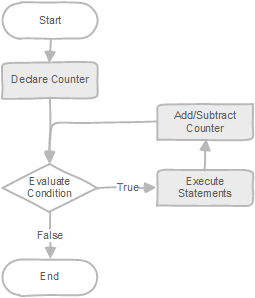PL/pgSQL For Loop
Summary: in this tutorial, you will learn about PL/pgSQL for loop statements to iterate over a range of integers or a result set of a query.
Using PL/pgSQL for loop to iterate over a range of integers
The following illustrates the syntax of the for loop statement that iterates over integers of a range:
[ <<label>> ]
for loop_counter in [ reverse ] from.. to [ by step ] loop
statements
end loop [ label ];In this syntax:
- First, the
forloop creates an integer variableloop_counterwhich is accessible only inside the loop. By default, theforloop increases theloop_counterbystepafter each iteration. However, when you use thereverseoption, theforloop decreases theloop_counterby thestep. - Second, the
fromandtoare expressions that specify the lower and upper bound of the range. Theforloop evaluates these expressions before entering the loop. - Third, the
stepthat follows thebykeyword specifies the iteration step. It is optional and defaults to 1. Thefor loopevaluates thestepexpression once only.
The following flowchart illustrates the for loop statement:
 The following example uses the
The following example uses the for loop statement to iterate over five numbers from 1 to 5 and display each of them in each iteration:
do
$$
begin
for counter in 1..5 loop
raise notice 'counter: %', counter;
end loop;
end;
$$;Output:
NOTICE: Counter: 1
NOTICE: Counter: 2
NOTICE: Counter: 3
NOTICE: Counter: 4
NOTICE: Counter: 5The following example iterates over 5 numbers from 5 to 1 and shows each of them in each iteration:
do $$
begin
for counter in reverse 5..1 loop
raise notice 'counter: %', counter;
end loop;
end; $$Output:
NOTICE: Counter: 5
NOTICE: Counter: 4
NOTICE: Counter: 3
NOTICE: Counter: 2
NOTICE: Counter: 1The following example uses the for loop statement to iterate over six numbers from 1 to 6. It adds 2 to the counter after each iteration:
do $$
begin
for counter in 1..6 by 2 loop
raise notice 'counter: %', counter;
end loop;
end; $$Output:
NOTICE: Counter 1
NOTICE: Counter 3
NOTICE: Counter 5Using PL/pgSQL for loop to iterate over a result set
The following statement shows how to use the for loop statement to iterate over a result set of a query:
[ <<label>> ]
for target in query loop
statements
end loop [ label ];The following statement uses the for loop to display the titles of the top 10 longest films.
do
$$
declare
f record;
begin
for f in select title, length
from film
order by length desc, title
limit 10
loop
raise notice '%(% mins)', f.title, f.length;
end loop;
end;
$$NOTICE: Chicago North(185 mins)
NOTICE: Control Anthem(185 mins)
NOTICE: Darn Forrester(185 mins)
NOTICE: Gangs Pride(185 mins)
NOTICE: Home Pity(185 mins)
NOTICE: Muscle Bright(185 mins)
NOTICE: Pond Seattle(185 mins)
NOTICE: Soldiers Evolution(185 mins)
NOTICE: Sweet Brotherhood(185 mins)
NOTICE: Worst Banger(185 mins)Using PL/pgSQL for loop to iterate over the result set of a dynamic query
The following form of the for loop statement allows you to execute a dynamic query and iterate over its result set:
[ <<label>> ]
for row in execute query_expression [ using query_param [, ... ] ]
loop
statements
end loop [ label ];In this syntax:
- The
query_expressionis an SQL statement. - The
usingclause is used to pass parameters to the query.
The following block shows how to use the for loop statement to loop through a dynamic query. It has two configuration variables:
sort_type: 1 to sort the films by title, 2 to sort the films by release year.rec_count: is the number of rows to query from thefilmtable. We’ll use it in theusingclause of theforloop.
This anonymous block composes the query based on the sort_type variable and uses the for loop to iterate over the row of the result set.
do $$
declare
-- sort by 1: title, 2: release year
sort_type smallint := 1;
-- return the number of films
rec_count int := 10;
-- use to iterate over the film
rec record;
-- dynamic query
query text;
begin
query := 'select title, release_year from film ';
if sort_type = 1 then
query := query || 'order by title';
elsif sort_type = 2 then
query := query || 'order by release_year';
else
raise 'invalid sort type %s', sort_type;
end if;
query := query || ' limit $1';
for rec in execute query using rec_count
loop
raise notice '% - %', rec.release_year, rec.title;
end loop;
end;
$$Output:
NOTICE: 2006 - Academy Dinosaur
NOTICE: 2006 - Ace Goldfinger
NOTICE: 2006 - Adaptation Holes
NOTICE: 2006 - Affair Prejudice
NOTICE: 2006 - African Egg
NOTICE: 2006 - Agent Truman
NOTICE: 2006 - Airplane Sierra
NOTICE: 2006 - Airport Pollock
NOTICE: 2006 - Alabama Devil
NOTICE: 2006 - Aladdin CalendarIf you change the sort_type to 2, you’ll get the following output:
NOTICE: 2006 - Grosse Wonderful
NOTICE: 2006 - Airport Pollock
NOTICE: 2006 - Bright Encounters
NOTICE: 2006 - Academy Dinosaur
NOTICE: 2006 - Ace Goldfinger
NOTICE: 2006 - Adaptation Holes
NOTICE: 2006 - Affair Prejudice
NOTICE: 2006 - African Egg
NOTICE: 2006 - Agent Truman
NOTICE: 2006 - Chamber ItalianIn this tutorial, you have learned various forms of the PL/pgSQL for loop statements